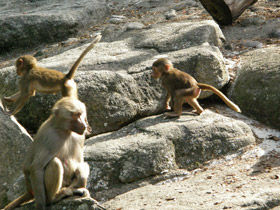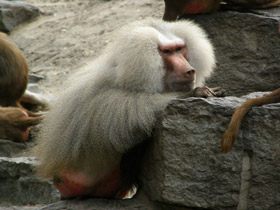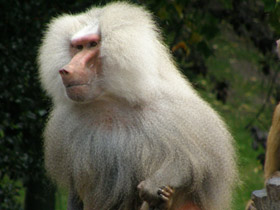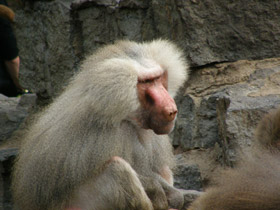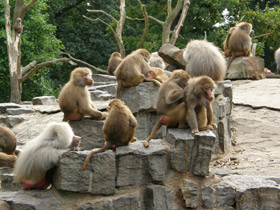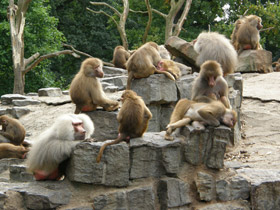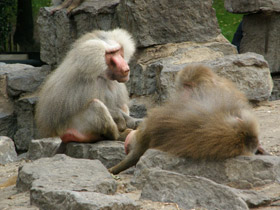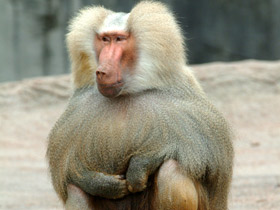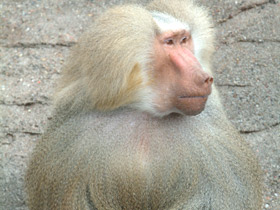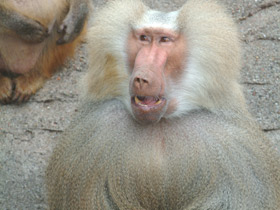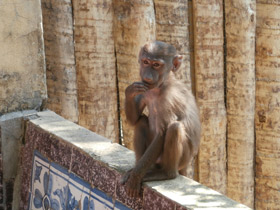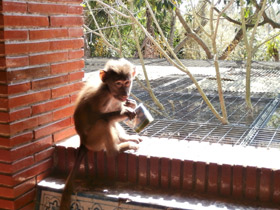The hamadryas baboon (Papio hamadryas)
The hamadryas baboon (Papio hamadryas /ˌhæməˈdraɪ.əs/) is a species of baboon within the Old World monkey family. It is the northernmost of all the baboons, being native to the Horn of Africa and the southwestern region of the Arabian Peninsula. These regions provide habitats with the advantage for this species of fewer natural predators than central or southern Africa where other baboons reside. The hamadryas baboon was a sacred animal to the ancient Egyptians and appears in various roles in ancient Egyptian religion, hence its alternative name of 'sacred baboon'.
Appearance
Papio hamadryas is a species of catarrhine primate in the family Cercopithecidae. Papio hamadryas is a large monkey, reaching 1 m in length (larger males), with a tail of 20-25 cm; females are half that length. The general colour of the fur covering the body of Papio hamadryas is grey (the colour of dry grass). Sexually mature males have a well-developed silvery mane (mantle) with a hair length of up to 25 cm - hence they are called strutting platypuses. Females have a shorter mane and dark olive-coloured fur, and the cubs resemble their mothers.
Habitat area
Widespread in the open lands of Africa (Ethiopia, Sudan, Somalia, southern Nubia) and Asia (Arabian Peninsula, Yemen). In ancient times, Papio hamadryas were also found in the Nile valley. Papio hamadryas were highly revered by the ancient Egyptians and dedicated to the sun god Ra, and the carcasses of Papio hamadryas were often mummified.
Social behaviour and nutrition
Papio hamadryas are usually found on rocky mountain slopes, sometimes in large herds of 80-100 or more individuals. Each group consists of adults, young and cubs; large flocks may contain 10-15 adult males.
The dominant position is held by a strong adult male, who usually earns the right to be the leader in a fight. The leader protects and maintains order in the flock, and separates the combatants. He is usually the first to realise danger and alerts the others by shouting. The leader has a harem of several females.
Females with newborns and calves have a privileged position. Adolescents and older females are the worst off in the herd.
Papio hamadryas sleep in crevices and under rock canopies, usually sitting close to each other, while the young sleep under the protection of their mothers.
Papio hamadryas are omnivorous: they eat juicy fruits, young shoots of plants, roots, lizards, insects, birds' eggs, and sometimes eat the birds themselves; they also raid fields, orchards and gardens.
As observations have shown, Papio hamadryas use some sixteen different sound signals, which have a specific meaning, to communicate with each other. In addition to sounds, they use expressive gestures, facial movements and even looks. For example, the leader may defuse a dispute with a stern look.
Threats and conservation
Transformation of field and pastureland represents the main threat to the hamadryas baboon; its only natural predators are the striped hyena, spotted hyena, and a diminishing number of African leopards that can still be found in the same area of distribution. The IUCN Red List listed this species as "least concern" in 2008. No major range-wide threats exist at present, although locally it may be at risk through loss of habitat due to major agricultural expansion and irrigation projects. The species occurs in the proposed Yangudi Rassa National Park, the Harar Wildlife Sanctuary, and a number of wildlife reserves in the lower Awash valley and in northern Eritrea.


















